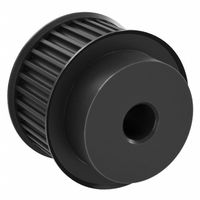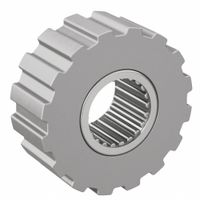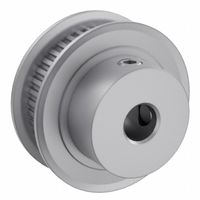Call +(254) 703 030 000 / 751 483 999 / 721 704 777
- Home
- Power Transmission
- Belts Pulleys
- Timing Belt Pulleys Idlers
.....Read More
Frequently Asked Questions
What is the difference between HTD and GT timing belt pulleys?
HTD (High Torque Drive) and GT (Gates Tooth) timing belt pulleys are both used in synchronous belt drive systems, but they have distinct differences:
1. **Tooth Profile**:
- **HTD**: Features a rounded tooth profile. This design allows for better load distribution and reduces the risk of belt slippage under high torque conditions.
- **GT**: Utilizes a modified curvilinear tooth profile, which provides improved load carrying capacity and reduced backlash compared to HTD.
2. **Load Capacity**:
- **HTD**: Suitable for moderate to high torque applications. The rounded teeth help in distributing the load evenly across the belt.
- **GT**: Offers higher load capacity and efficiency. The design minimizes tooth deformation and optimizes the contact area between the belt and pulley.
3. **Backlash**:
- **HTD**: Generally has more backlash due to its rounded tooth design, which can be a disadvantage in precision applications.
- **GT**: Designed to minimize backlash, making it more suitable for applications requiring high precision and accuracy.
4. **Efficiency**:
- **HTD**: Provides good efficiency but may not be as high as GT in certain applications.
- **GT**: Typically offers higher efficiency due to its optimized tooth profile, which reduces friction and wear.
5. **Applications**:
- **HTD**: Commonly used in industrial applications where high torque is required, such as conveyors and heavy machinery.
- **GT**: Preferred in applications requiring precision and high efficiency, such as robotics and CNC machines.
6. **Noise and Vibration**:
- **HTD**: May produce more noise and vibration due to its design.
- **GT**: Generally quieter and smoother in operation due to its refined tooth profile.
In summary, while both HTD and GT timing belt pulleys are effective for power transmission, GT pulleys offer advantages in precision, efficiency, and reduced backlash, making them suitable for more demanding applications.
How do I choose the right timing belt pulley for my application?
To choose the right timing belt pulley for your application, consider the following factors:
1. **Belt Type and Size**: Identify the type and size of the timing belt you are using. Ensure the pulley is compatible with the belt's pitch, width, and tooth profile.
2. **Load Requirements**: Determine the load the pulley will handle. This includes the torque and power requirements of your application. Choose a pulley material and size that can withstand these loads without excessive wear or failure.
3. **Speed and Ratio**: Calculate the desired speed ratio between the driving and driven pulleys. This will help in selecting the correct number of teeth for each pulley to achieve the required speed and torque.
4. **Shaft Size**: Ensure the pulley bore matches the shaft size of your application. Consider using bushings or adapters if necessary for a secure fit.
5. **Environmental Conditions**: Consider the operating environment, including temperature, humidity, and exposure to chemicals or debris. Choose materials and coatings that can withstand these conditions, such as aluminum, steel, or plastic.
6. **Alignment and Tensioning**: Ensure the pulley system allows for proper alignment and tensioning of the belt to prevent slippage and wear. Consider using adjustable mounts or tensioners.
7. **Space Constraints**: Evaluate the available space for the pulley system. Ensure the pulley size fits within the spatial limitations of your application.
8. **Cost and Availability**: Consider the cost and availability of the pulley. Balance the need for quality and performance with budget constraints.
9. **Manufacturer Specifications**: Consult manufacturer catalogs and specifications to ensure compatibility and performance standards are met.
By carefully evaluating these factors, you can select a timing belt pulley that meets the specific needs of your application, ensuring efficient and reliable operation.
What are the advantages of using urethane carbon timing belt pulleys?
Urethane carbon timing belt pulleys offer several advantages:
1. **Durability**: Urethane is highly resistant to wear, abrasion, and environmental factors such as moisture and chemicals, which enhances the longevity of the pulleys.
2. **Lightweight**: Carbon fiber reinforcement makes these pulleys significantly lighter than traditional metal pulleys, reducing the overall weight of machinery and improving efficiency.
3. **Strength and Stiffness**: The carbon fiber provides exceptional tensile strength and stiffness, ensuring reliable performance under high load conditions without deformation.
4. **Corrosion Resistance**: Unlike metal pulleys, urethane carbon pulleys do not corrode, making them ideal for use in harsh or corrosive environments.
5. **Noise Reduction**: The material properties of urethane help in dampening vibrations and reducing noise, leading to quieter operation.
6. **Precision and Stability**: These pulleys maintain precise timing and positioning, which is crucial for applications requiring high accuracy and synchronization.
7. **Low Maintenance**: The durability and resistance to environmental factors mean less frequent maintenance and replacement, reducing downtime and operational costs.
8. **Flexibility in Design**: Urethane can be molded into complex shapes, allowing for customized designs to meet specific application requirements.
9. **Energy Efficiency**: The lightweight nature and reduced friction of urethane carbon pulleys contribute to lower energy consumption in machinery.
10. **Temperature Resistance**: They can operate effectively over a wide range of temperatures, maintaining performance in both high and low-temperature environments.
These advantages make urethane carbon timing belt pulleys a preferred choice in various industries, including automotive, aerospace, and manufacturing, where performance, reliability, and efficiency are critical.
How do timing belt idler pulleys work?
Timing belt idler pulleys are crucial components in an engine's timing system, ensuring the timing belt maintains proper tension and alignment. These pulleys are typically mounted on a fixed bracket and do not drive any components themselves. Instead, they serve to guide and support the timing belt as it loops around various engine components like the camshaft and crankshaft.
The idler pulley consists of a wheel with a smooth or grooved surface, depending on the belt type, and a bearing that allows it to spin freely. The bearing is usually sealed to prevent dirt and debris from entering, which could cause wear or failure. The pulley is strategically positioned to maintain the correct path and tension of the timing belt, preventing it from slipping or jumping teeth on the sprockets, which could lead to engine misalignment and potential damage.
In some systems, the idler pulley is adjustable, allowing for fine-tuning of the belt tension. This adjustment is crucial during installation or replacement of the timing belt to ensure optimal performance and longevity. Proper tension is vital as too much tension can cause excessive wear on the belt and pulleys, while too little can lead to slippage and timing issues.
Overall, timing belt idler pulleys play a vital role in the smooth operation of an engine by maintaining the correct tension and alignment of the timing belt, ensuring precise timing of the engine's internal components. Regular inspection and maintenance of these pulleys are essential to prevent engine performance issues and extend the life of the timing belt system.
What are the common pitch sizes for trapezoidal timing belt pulleys?
Common pitch sizes for trapezoidal timing belt pulleys include:
- MXL (Miniature Extra Light): 0.080 inches (2.032 mm)
- XL (Extra Light): 0.200 inches (5.08 mm)
- L (Light): 0.375 inches (9.525 mm)
- H (Heavy): 0.500 inches (12.7 mm)
- XH (Extra Heavy): 0.875 inches (22.225 mm)
- XXH (Double Extra Heavy): 1.250 inches (31.75 mm)
These pitch sizes are standardized to ensure compatibility between belts and pulleys across different manufacturers.
How do I maintain and replace timing belt pulleys?
To maintain and replace timing belt pulleys, follow these steps:
1. **Inspection**: Regularly inspect the timing belt and pulleys for wear, cracks, or damage. Look for signs of oil contamination or misalignment.
2. **Preparation**: Gather necessary tools such as a wrench set, socket set, screwdrivers, and a torque wrench. Ensure you have the correct replacement pulleys and timing belt for your vehicle model.
3. **Safety**: Disconnect the battery to prevent accidental starts. Ensure the vehicle is on a stable surface and use jack stands if needed.
4. **Access**: Remove any components obstructing access to the timing belt cover, such as the serpentine belt, engine covers, or accessories.
5. **Remove Timing Belt Cover**: Carefully remove the timing belt cover to expose the belt and pulleys.
6. **Mark Timing**: Before removing the belt, mark the timing positions on the camshaft and crankshaft pulleys to ensure proper alignment during reassembly.
7. **Remove Belt**: Loosen the tensioner pulley to remove the timing belt. Inspect the belt for wear and replace if necessary.
8. **Replace Pulleys**: Remove the old pulleys using the appropriate tools. Install new pulleys, ensuring they are properly aligned and torqued to the manufacturer's specifications.
9. **Install New Belt**: Position the new timing belt over the pulleys, maintaining the marked timing positions. Adjust the tensioner to apply the correct tension to the belt.
10. **Reassemble**: Reinstall the timing belt cover and any other components removed earlier. Reconnect the battery.
11. **Test**: Start the engine and listen for unusual noises. Check for proper operation and alignment.
12. **Regular Maintenance**: Follow the vehicle manufacturer's recommended maintenance schedule for timing belt and pulley replacement to prevent engine damage.
What are the benefits of using SilentSync series timing belt pulleys?
SilentSync series timing belt pulleys offer several benefits:
1. **Reduced Noise**: These pulleys are designed to operate quietly, minimizing noise pollution in industrial environments. The unique tooth profile and belt design help in reducing the sound generated during operation.
2. **High Efficiency**: SilentSync pulleys provide high power transmission efficiency. The precise tooth engagement ensures minimal slippage, leading to better energy transfer and reduced energy loss.
3. **Durability and Longevity**: Made from high-quality materials, these pulleys are resistant to wear and tear, extending the lifespan of both the pulleys and the belts. This durability reduces the need for frequent replacements and maintenance.
4. **Compact Design**: The design allows for a more compact setup, which is beneficial in applications where space is limited. This compactness does not compromise the power transmission capabilities.
5. **Versatility**: SilentSync pulleys are suitable for a wide range of applications, from light-duty to heavy-duty industrial uses. They can be used in various industries, including automotive, manufacturing, and packaging.
6. **Improved Load Capacity**: The design of the SilentSync series allows for better load distribution across the belt, enhancing the load-carrying capacity and performance of the system.
7. **Energy Savings**: The efficient design contributes to energy savings, as less power is required to achieve the same level of performance compared to traditional belt systems.
8. **Easy Installation and Maintenance**: These pulleys are designed for easy installation and require minimal maintenance, reducing downtime and operational costs.
9. **Enhanced Synchronization**: The precise tooth geometry ensures accurate synchronization between the belt and pulley, which is crucial for applications requiring precise timing and positioning.
Overall, SilentSync series timing belt pulleys offer a combination of efficiency, durability, and performance, making them a valuable component in various mechanical systems.






